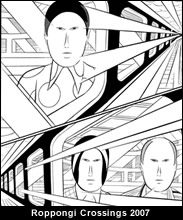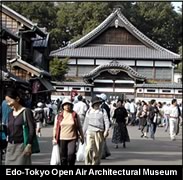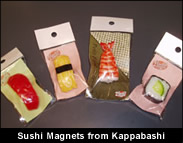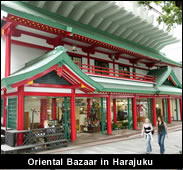 |
 |
 |
 |
 |
 |
- News & Announcements
- Featured Event - Lightopia (Marunouchi)
- Featured Museum - Edo Tokyo Open Air Architectural Museum
- Budget Tokyo
- Upcoming Events
- Online Resources
|
 |
|
Yurakucho Area Revitalization
The ongoing redevelopment of the Yurkakucho/Ginza area continues with the
addition of some exciting shopping venues. Those looking to expand on their
Tokyo shopping experience can now enjoy the brand new Yurakucho Marui department
store located in the recently opened Yurakucho Itocia shopping complex,
and the Marronnier Gate shopping complex which is home to Ginza Hands,
an exclusive and upscale branch of the very popular Tokyu Hands DIY stores.
Yurakucho Itocia - http://www.itocia.jp/
(Japanese)
Marronnier Gate - http://www.marronniergate.com/
(Japanese)
Japan Post Privatized
Japan Post, the public postal service company, was recently split into
four firms under a holding company as the first step in the privatization
process. The four units are in charge of mail delivery, postal savings,
insurance and over-the-counter services.
http://search.japantimes.co.jp/cgi-bin/nb20071002a3.html
Please note that Japan Post has a new logo (viewable here - http://www.japanpost.jp/en/)
and that the Japan Post Bank will continue to offer an international ATM
service. To see which ATM and credit cards work with the service, please
visit:
http://www.jp-bank.japanpost.jp/en/ias/en_ias_index.html
Roppongi Crossing 2007: Future Beats in Japanese Contemporary
Art
From October 13 to January 14, The Mori Art Museum in Roppongi will be
featuring a series of exhibitions introducing Japanese creative talent.
There will be 36 artists in total whose work has an energy and sphere of
influence that spreads beyond the confines of conventional artistic categories.
Their art takes a variety of forms, including painting, sculpture, photography,
design, video, manga, games, and even unlikely genres such as doll making
and bathhouse mural painting.
http://www.mori.art.museum/html/english/contents/roppongix02/index.html
New Entry Procedures for All Foreign Tourists Visiting Japan
Effective November 20, 2007
For details, please see the linked document below:
http://www.immi-moj.go.jp/keiziban/happyou/pdf/poster-english.pdf
(PDF)
|

|
|
 |
|
|
 |
Edo-Tokyo Open Air Architectural
Museum (Tatemon-En)
A branch of the Edo-Tokyo Museum, the Edo-Tokyo Tatemono-En is an impressive,
open air museum. Situated in western Tokyo’s Koganei Park, the museum showcases
buildings from the late Edo Period to the 1950s, arranged along streets
in a village setting. It has been said that film director, Hayao Miyazaki,
visited the museum for inspiration in creating his famous animated film
'Sprited Away' (Sen to Chihiro no Kamikakushi). Free English guide services
are available but must be booked at least 15 days in advance.
http://www.frommers.com/destinations/tokyo/A23478.html
http://tatemonoen.jp/index.html
(Japanese)
The closest station to the museum is JR Musahi Koganei, followed by a 5
minutes bus ride. |

|
|
 |
With the gift giving season fast approaching,
try visiting the Tokyo establishments listed below and discover some amazing
deals.
Kappabashi Dori
The famous Tokyo restaurant wholesale district that sells everything from
sushi inspired souvenirs, plastic display food, crockery, kitchenware,
to factory-made ceramics at bargain prices.
Access: Tokyo Metro Tawaramachi Station (Ginza Line)
http://www.kappabashi.or.jp/
(Japanese)
http://wikitravel.org/en/Tokyo/Asakusa#Buy
Oriental Bazaar
A popular, one-stop souvenir shop that guarantees you will find reasonably
priced Japanese gifts from yukatas, plastic samurai swords, paper products,
lamps, fans, to pottery.
Access: JR Harajuku Station, Tokyo Metro Meiji-Jingumae & Omotesando Stations
http://www.frommers.com/destinations/tokyo/S27115.html
Akihabara Denkigai
Also known as Akihabara Electric Town, this area is best known for its
amazing collection of electronic shops. Here you will find everything from
the latest electronic gadgets to electronic home appliances, all offered
at great prices. Many shops offer duty free prices and multilingual service.
http://www.akiba.or.jp/english/index.html
http://www.jnto.go.jp/eng/location/regional/tokyo/akihabara.html
Antique Flea Markets
If you are looking for something unique to fill your Christmas stockings,
check out the following Antique Flea Markets.
"A Tokyo Weekend At a Flea Market"
http://query.nytimes.com/gst/fullpage.html?sec=travel&
res=9D0CE6D7153DF935A35753C1A967958260
Oedo Antiques Fair (Yurakucho)
Every first and third Sunday of the month
http://www.jnto.go.jp/eng/arrange/attractions/practical/kottou.html
Togo Shrine (Harajuku)
First and Fourth Sunday of the month (except December)
http://www.kottouichi.jp/tougou.htm
(Japanese)
100 Yen Shop
Ranging from multi-storey to small corner store, 100 Yen Shops sell a wide
variety of products for 105 yen per item (100 yen plus 5% consumption tax).
Here you can find Japanese goods from chopsticks, ceramics and housewares
to makeup, bath products, and home decoration products, all for an unbeatable
prices. Below is a list of 100 yen shops in Tokyo:
http://www.japan-guide.com/e/e2077.html
Daiso (Harajuku, Machida, Kinshicho, etc)
http://www.daiso-sangyo.co.jp/english/index.html
Silk (Mitaka, Shinjuku, Ueno, etc)
http://www.ohthree.co.jp/english/index.asp
|


|
|
 |
| Dezomeshiki
January 6, 2008 (Tokyo Big Sight)
A grand parade and acrobatic stunts by firefighters wearing traditional
outfits.
http://web-japan.org/kidsweb/explore/calendar/january/dezomeshiki.html
Tokyo Auto Salon 2008 with NAPAC
January 12 & 13, 2008 (Makuhari Messe, Chiba)
The premier destination for car enthusiasts to explore the latest industry
trends, gadgets and concept cars.
http://www.e-autosalon.net/tokyo/english/index.html
Antique Jamboree
January 12 & 13, 2008 (Tokyo Big Sight)
Japan’s premier antique fair attracts 500 dealers selling everything from
Western and Japanese goods to toy collectibles in the waterfront Ariake
area.
http://home.att.ne.jp/sun/jambokun/antique/e.html
The January Basho (Sumo Wrestling)
January 13 - 27, 2008 (Kokugikan Sumo Hall)
Sumo is one of Japan’s most popular traditional sports. This is a sport
with over 70 different throws, trips, forms and tricks. The January Basho
is one of the year’s six Grand Tournaments. Two other tournaments hosted
in Tokyo are held in May and September.
http://www.sumo.or.jp/eng/index.html
Darumaichi
February 3, 2008 (Nishiarai-daishi Temple)
At Nishiarai-daishi Temple, good luck Daruma dolls are sold.
http://www.tourism.metro.tokyo.jp/english/topics/030121/5.html
Tokyo Marathon 2008
February 17, 2008 (Shinjuku ? Start)
Tokyo's large-scale city marathon kicks off at 9:00 AM from the Tokyo Metropolitan
Government building. Runners then make their way past the Imperial Palace,
through Ginza and Asakusa before completing the course at Tokyo Big Sight
in Odaiba.
http://www.tokyo42195.org/index_en.html
EXPERIENCE "THE JAPANESE NEW YEAR"
From the end of the year to the start of spring, there are
many Japanese traditions to welcome the New Year. The accompanying events
provide a great opportunity for visitors to experience traditional Japanese
culture.
Joya no Kane
December 31, 2007 (Various locations)
At midnight, temple bells are struck 108 times to dispel the 108 earthly
desires that, according to Buddhist doctrine plague us all. Many Japanese
go to a shrine or temple to hear the bells while praying for good luck
and health. The first 108 people are sometimes given the opportunity to
ring the bell. To participate in the bell ringing, try one of the following
locations:
Zojo-ji Temple
Access: Onarimon Station - (Mita Line) *near Tokyo Tower
Costs 2,000 yen per group of four.
http://www.tokyoessentials.com/zojoji-temple.html
Gokoku-ji Temple
Access: Gokokuji Station - Exit 1 (Yurakucho Line)
1,000 yen per person with a maximum of 108 people participating.
Tsukiji Hongan-ji
Access: Tsukiji Station - Hibiya Line
http://www.tsukijihongwanji.jp/tsukiji/index_e.html
Hatsumode
January 1, 2008 (Various locations ? Meiji Jingue Shrine, Sensoji Temple)
People in traditional kimono pray for good fortune at shrines and temples.
http://metropolis.co.jp/tokyoculturearchive349/300/tokyocultureinc.htm
Tako-age (Kite-Flying)
January 2008 (Arakawa Todabashi Ryokuchi Recreation Ground)
Welcome the New Year with a day of traditional Japanese kite flying.
http://www.istc.org/sisp/index.htm?fx=event&event_id=61417
Tako are square-shaped kites traditionally made with paper glued to a bamboo
frame, decorated with pictures of Kabuki actors, warriors and Japanese
writing. Young boys customarily flew kites to wish for their healthy growth;
the idea was that they would be picked up by the wind and brought to heaven.
Traditional Japanese kite making can be experienced at the Kite Museum
in Nihonbashi, a ten minute walk from JR Tokyo Station's Yaesu Central
Exit.
http://www.tako.gr.jp/eng/museums_e/tokyo_e.html
http://www.monodukuri-net.com/new/3rd/hakubutsukan/tako/tako_eng.html
Kokyo Ippan Sanga
January 2, 2008 (Imperial Palace Grounds)
One of only two days when Imperial Palace grounds are open to the public
and where visitors can catch a glimpse of the Imperial Family. Entrance
to the gardens is by Nijubashi Bridge.
http://en.wikipedia.org/wiki/Kokyo
Tondo-yaki
January 20, 2008 (Torigoe Jinja Shrine, Taito-ku)
New Year's decorations of pine and straw are taken to Torigoe Jinja Shrine
for a bonfire. Pounded rice cakes, cooked in the embers, are consumed in
hopes of bringing good health. Bring your new year holiday decorations
and burn them to pray for good health and fortune.
http://hix05.com/nenju/tondo/tondo.html
(Japanese)
Setsubun
February 2008 (Senso-ji Temple)
A traditional custom performed to welcome spring. Join the crowds as they
throw soybeans while shouting “Oni wa soto! Fuku wa uchi” or “Fortune in!
Devils out!.” The soybeans are meant to have the power to destroy the eyes
of the demons.
http://www.istc.org/sisp/index.htm?fx=event&event_id=65311
|
|
|
 |
|
|
 |
 |
 |
| |
|
To access the previous edition of e-Tokyo Today and our printed newsletter, Tokyo Today,
please visit: http://www.tourism.metro.tokyo.jp/english/citypromotion/index.html.
If you wish to stop receiving this newsletter, please send an email to news@tcvb.or.jp titled, "Unsubscribe".
Issued by: Tourism Division, Bureau of Industrial and Labor Affairs,
Tokyo Metropolitan Government
Planning / Editing: Tokyo Convention & Visitors Bureau
E-mail: news@tcvb.or.jp Tel: +81-3-5840-8892
Fax: +81-3-5840-8895.
|
|
|
|
